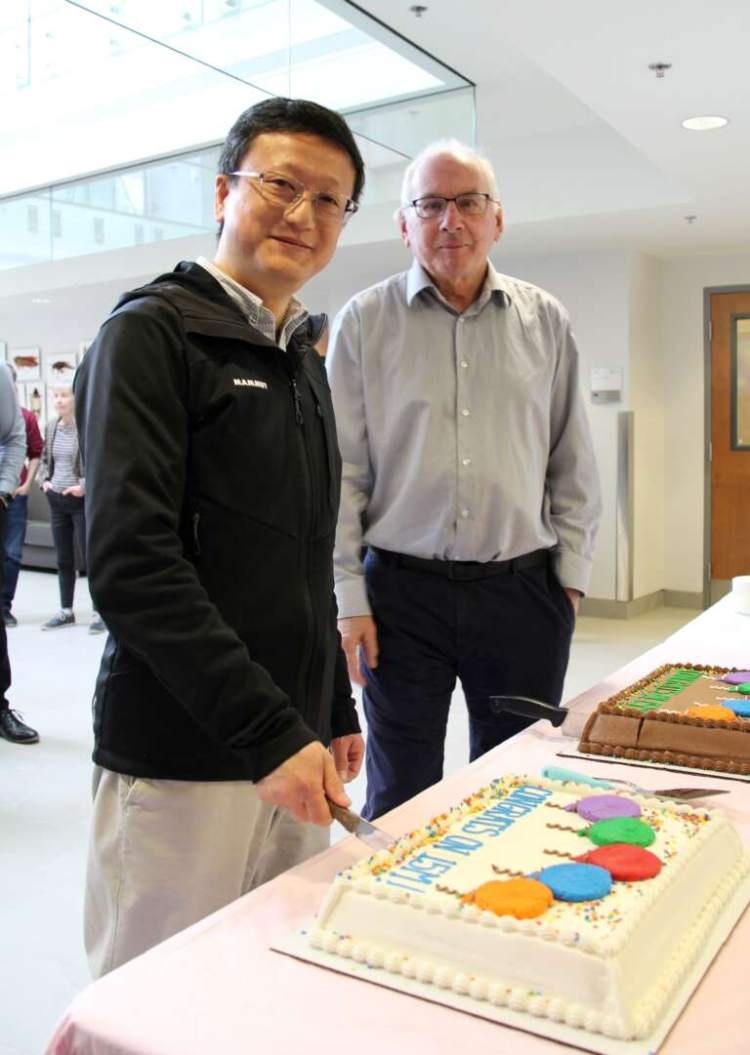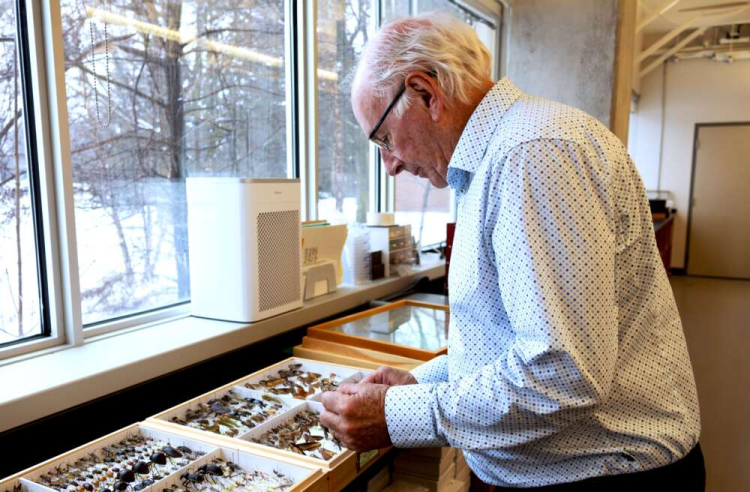A tiny beetle from Costa Rica has just made scientific history, becoming the 15 millionth specimen in an archive that underpins an effort to build a genetic reference library cataloguing all life on Earth.
That library lives at the Centre for Biodiversity Genomics (CBG) at the University of Guelph, which has an ambitious mission to collect, digitize and sequence every multi-cellular species on the planet.
In the same way a barcode identifies a product at a supermarket, the CBG uses a DNA-based identification method to analyze and catalogue specimens.
Dr. Paul Hebert, CBG's founder and CEO, pioneered the method more than 20 years ago which uses short sections of any specimen's genome to accurately identify its species.
It took 15 years for the CBG's specimen archive to reach 5 million specimens. Just five years later, that collection has tripled, thanks to big advances in the DNA barcoding field.

Drs. Xin Zhou and Paul Hebert celebrate the 15M specimen
The 15 millionth specimen is a long-horned beetle, a Placosternus guttatus, collected in Guanacaste, Costa Rica. It's a tiny insect that represents a big moment for Hebert.
"It's a nice milestone to achieve," says Hebert. "It puts us in the upper ranks of collections in Canada and we're within stretch distance of some of the world's largest collections."
Those major natural history collections have been acquiring specimens for more than a century, he notes. But CBG has accomplished this feat in just two decades while becoming the largest digital DNA archive in the world.
"There's nowhere that has more organisms digitally registered than we have at U of G," Hebert says. "This is a brave new digital world. And we want all of humanity to have access to the specimen images, their sequences and geographical coordinates."
Most specimens processed at the CBG are stored in its ever-growing archive. Others are returned to their country of collection, with their digital DNA footprint added to the CBG's Barcode of Life Data System (BOLD). This free portal has become the international standard for DNA-based species identification.
The sequencing work done by the team at CBG can be found in collections across the globe, says Hebert.
"You can travel the world and find specimens that were processed here."
Understanding our world through biodiversity

The Centre for Biodiversity Genomics specimen collection at the University of Guelph holds thousands of insect specimens
BOLD's aim is to break down global barriers in biodiversity research, explains biologist Dr. Xin Zhou, who oversees the CBG's specimen unit.
"Our goal is to digitize all global life. With that goal set, every unit within CBG is working to achieve it."
Zhou, who worked at CBG as a post-doctoral researcher 18 years ago, returned to the centre in early 2025 as the Canada Research Chair in Eukaryote Biodiversity Genomics.
"We thought we were doing high specimen output back then. But compared to what we have now, it was really nothing," he says.
Over the past two decades, CBG researchers have worked to improve every step in specimen processing. In 2005, it cost around $20 per specimen to gather a high-quality sequence. That has now fallen to a tenth of a cent.
Thanks to continuous technological improvements, CBG now processes around 50,000 specimens each week. The latest DNA sequencers even allow analysis to be completed at remote field stations.
Global reach of DNA barcoding
Hebert says the larger goal is to explain biodiversity, as well as to track how humans are altering it.
"We're living in a time of potential mass extinction," Hebert says. "The thought of losing all these species without preserving them so we can read their genomes is something humanity would regret for a long time."
Hebert's biodiversity genomics work has earned him global recognition as the "father of DNA barcoding," as well as the Heineken Prize for Environmental Sciences (2018), the MIDORI Prize for Biodiversity (2020) and the Benjamin Franklin Medal for Earth and Environmental Science (2024).
Most of the specimens in CBG's collection are insects, an often-overlooked indicator of biodiversity and healthy ecosystems.
"Insects are beyond the creatures that everybody hates," Zhou says. "They're part of the natural world and they provide essential functions. Without insects, we're not humans."
Helping to accelerate specimen collection has been the BIOSCAN project, which brings together researchers from more than 40 nations who share the goal of creating a planetary biodiversity observation system.
Among the 15 million specimens housed at CBG, around half were collected as part of BIOSCAN, helping to make CBG's collection richer and more diverse.
"We'll never be able to achieve our goal if we just focus on Canada, because we have limited diversity here," Zhou says. "BIOSCAN increased our reach and allowed us to grow our collection at an even faster pace."
Now, with 15 million specimens in its archives, the CBG team has shifted focus to its next milestones: 25 million specimens by 2029 and then all life on Earth by 2045.












